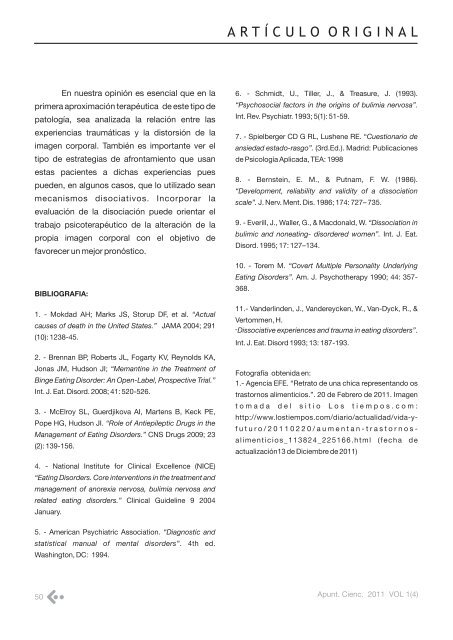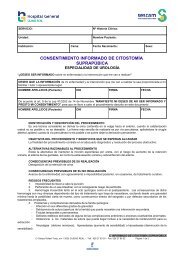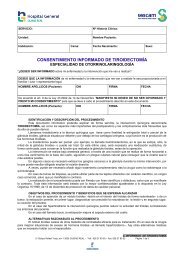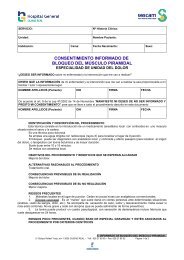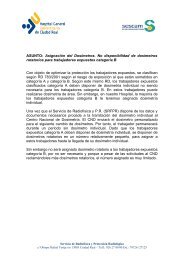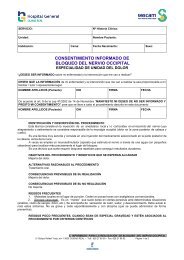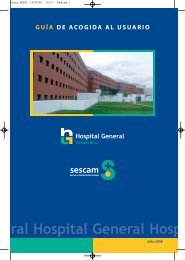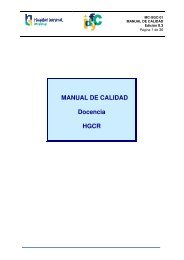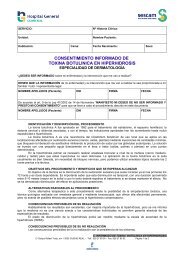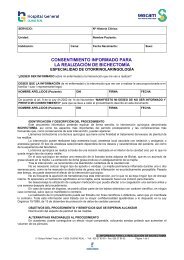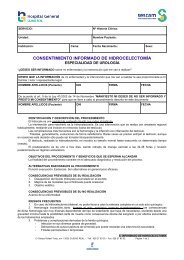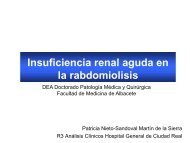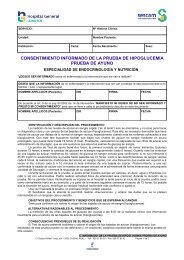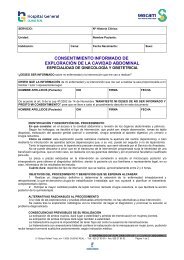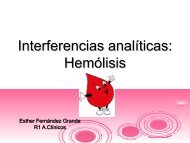APUNTES DE CIENCIA - hgucr
APUNTES DE CIENCIA - hgucr
APUNTES DE CIENCIA - hgucr
Create successful ePaper yourself
Turn your PDF publications into a flip-book with our unique Google optimized e-Paper software.
A R T Í C U L O O R I G I N A L<br />
En nuestra opinión es esencial que en la<br />
primera aproximación terapéutica de este tipo de<br />
patología, sea analizada la relación entre las<br />
experiencias traumáticas y la distorsión de la<br />
imagen corporal. También es importante ver el<br />
tipo de estrategias de afrontamiento que usan<br />
estas pacientes a dichas experiencias pues<br />
pueden, en algunos casos, que lo utilizado sean<br />
mecanismos disociativos. Incorporar la<br />
evaluación de la disociación puede orientar el<br />
trabajo psicoterapéutico de la alteración de la<br />
propia imagen corporal con el objetivo de<br />
favorecer un mejor pronóstico.<br />
BIBLIOGRAFIA:<br />
1. - Mokdad AH; Marks JS, Storup DF, et al. “Actual<br />
causes of death in the United States.” JAMA 2004; 291<br />
(10): 1238-45.<br />
2. - Brennan BP, Roberts JL, Fogarty KV, Reynolds KA,<br />
Jonas JM, Hudson JI; “Memantine in the Treatment of<br />
Binge Eating Disorder: An Open-Label, Prospective Trial.”<br />
Int. J. Eat. Disord. 2008; 41: 520-526.<br />
3. - McElroy SL, Guerdjikova AI, Martens B, Keck PE,<br />
Pope HG, Hudson JI. “Role of Antiepileptic Drugs in the<br />
Management of Eating Disorders.” CNS Drugs 2009; 23<br />
(2): 139-156.<br />
6. - Schmidt, U., Tiller, J., & Treasure, J. (1993).<br />
“Psychosocial factors in the origins of bulimia nervosa”.<br />
Int. Rev. Psychiatr. 1993; 5(1): 51-59.<br />
7. - Spielberger CD G RL, Lushene RE. “Cuestionario de<br />
ansiedad estado-rasgo”. (3rd.Ed.). Madrid: Publicaciones<br />
de Psicología Aplicada, TEA: 1998<br />
8. - Bernstein, E. M., & Putnam, F. W. (1986).<br />
“Development, reliability and validity of a dissociation<br />
scale”. J. Nerv. Ment. Dis. 1986; 174: 727– 735.<br />
9. - Everill, J., Waller, G., & Macdonald, W. “Dissociation in<br />
bulimic and noneating- disordered women”. Int. J. Eat.<br />
Disord. 1995; 17: 127–134.<br />
10. - Torem M. “Covert Multiple Personality Underlying<br />
368.<br />
11.- Vanderlinden, J., Vandereycken, W., Van-Dyck, R., &<br />
Vertommen, H.<br />
“Dissociative experiences and trauma in eating disorders”.<br />
Int. J. Eat. Disord 1993; 13: 187-193.<br />
Fotografía obtenida en:<br />
1.- Agencia EFE. “Retrato de una chica representando os<br />
trastornos alimenticios.”. 20 de Febrero de 2011. Imagen<br />
t o m a d a d e l s i t i o L o s t i e m p o s . c o m :<br />
Eating Disorders”. Am. J. Psychotherapy 1990; 44: 357-<br />
http://www.lostiempos.com/diario/actualidad/vida-yf<br />
u t u r o / 2 0 1 1 0 2 2 0 / a u m e n t a n - t r a s t o r n o s -<br />
alimenticios_113824_225166.html (fecha de<br />
actualización13 de Diciembre de 2011)<br />
4. - National Institute for Clinical Excellence (NICE)<br />
“Eating Disorders. Core interventions in the treatment and<br />
management of anorexia nervosa, bulimia nervosa and<br />
related eating disorders.” Clinical Guideline 9 2004<br />
January.<br />
5. - American Psychiatric Association. “Diagnostic and<br />
statistical manual of mental disorders”. 4th ed.<br />
Washington, DC: 1994.<br />
50 Apunt. Cienc. 2011 VOL 1(4)


